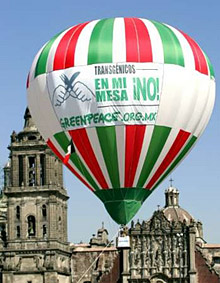 |
 |
 |
 Editorials | Environmental | November 2005 Editorials | Environmental | November 2005  
Genetically Altered Food Protested
 Associated Press Associated Press


| | Greenpeace activists stage a protest against genetically modified food with a hot air balloon that reads: 'Transgenic Crops in My Food, NO' in Mexico City's Zocalo, or main square. (Reuters/Henry Romero) |
Mexico City - Greenpeace on Sunday tethered a hot-air balloon over the sprawling, historic city center of Mexico's capital to grab the public's attention as part of an educational campaign about the use of transgenetic crops by major food producers.

The green, red and white balloon hovered across from the national palace and near the country's cathedral in a public plaza that fills with visitors on weekends.

The message "Transgenetics, not on my table!" was printed across the balloon, next to a depiction of a pair of hands holding a knife and fork.

Arteli Carreon, who is coordinating the biotech product information campaign for Greenpeace Mexico, said 31 genetic modifications had been approved in this country for use in corn, soy, potatoes, tomatoes, canola oil and alfalfa - but that many food companies do not label products that have been altered or contain altered substances.

"Trangenetics are present in two out of every three products sold at the supermarket," Carreon said. "Most of the population doesn't know that."

She said scientists don't know for sure if eating genetically modified foods is harmful for humans.

"No one can guarantee that the consumption of these foods won't hurt the consumer as well as the environment in the medium or long term," Carreon said.

Walking near the balloon, Emilio Mendoza said he had never before heard of biotech food products.

"This is important because it's one's health," he said, adding that many food producers "are only interested in increasing sales. One's health doesn't interest them much."

This summer, a study by government and academic scientists found no trace of genetically altered corn in southern Mexico - four years after reports of its discovery there caused concerns that a modified intruder could contaminate the birthplace of maize.

But the findings reflect only recent conditions, not necessarily future trends, concluded the study, done in the Sierra de Juarez region in the southern state of Oaxaca, the same mountainous area where researchers found evidence of transgenic corn contamination in 2000.

The origins of corn can be traced back to Mexico, where 59 different species survive. | 
 | |
 |



